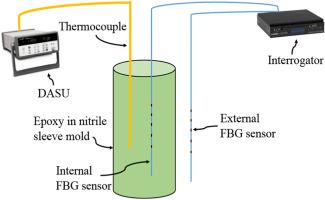当前位置:
X-MOL 学术
›
Compos. Sci. Technol.
›
论文详情
Our official English website, www.x-mol.net, welcomes your feedback! (Note: you will need to create a separate account there.)
FBG monitoring of curing in single fiber polymer composites
Composites Science and Technology ( IF 9.1 ) Pub Date : 2020-09-01 , DOI: 10.1016/j.compscitech.2020.108308 S. Khadka , J. Hoffman , M. Kumosa
Composites Science and Technology ( IF 9.1 ) Pub Date : 2020-09-01 , DOI: 10.1016/j.compscitech.2020.108308 S. Khadka , J. Hoffman , M. Kumosa

|
Abstract In this study, a fiber Bragg grating (FBG) sensor and a thermocouple (TC) were embedded inside an epoxy system cured at 121 °C to determine its curing characteristics. The curing behavior of this higher temperature (HT) system was also compared with a room temperature (RT) epoxy cured at 30 °C to independently verify the recently published approach developed for the RT system (Ref. 1; Hoffman, Khadka and Kumosa, 2020). The previously suggested algorithms developed to extract the gel point, the end of cure, and the curing and manufacturing strains for the RT system were successfully applied to the HT epoxy. This methodology was effectively extended to include the start of cure determination for the HT system. It was established that the manufacturing strains of both resin systems significantly exceeded the strains which could be predicted from the thermal contraction of the resins cooling from the ambient curing temperature to RT especially for the HT epoxy. The curing strains in both epoxy systems were shown to be significant, contributing to the overall manufacturing strains approximately 28% for the RT epoxy and about 45% for the HT resin. Efforts were also made to explain the source of sizable scatters in the strain measurements by evaluating temperature variations within individual and across multiple curing samples. As previously conjectured, the local temperature concentrations (hot spots) were responsible for the scatters in the strain measurements.
中文翻译:

单纤维聚合物复合材料固化的 FBG 监测
摘要 在这项研究中,将光纤布拉格光栅 (FBG) 传感器和热电偶 (TC) 嵌入在 121 °C 下固化的环氧树脂系统中,以确定其固化特性。还将这种高温 (HT) 系统的固化行为与在 30 °C 下固化的室温 (RT) 环氧树脂进行比较,以独立验证最近发布的为 RT 系统开发的方法(参考文献 1;Hoffman、Khadka 和 Kumosa, 2020)。先前为提取 RT 系统的凝胶点、固化结束以及固化和制造应变而开发的建议算法已成功应用于 HT 环氧树脂。该方法有效地扩展到包括 HT 系统固化确定的开始。已经确定,两种树脂系统的制造应变显着超过了可以通过树脂从环境固化温度冷却到室温的热收缩预测的应变,尤其是对于 HT 环氧树脂。两种环氧树脂体系中的固化应变都被证明是显着的,对 RT 环氧树脂和 HT 树脂的总体制造应变贡献约 28% 和约 45%。还努力通过评估单个和多个固化样品内的温度变化来解释应变测量中大量散射的来源。如前所述,局部温度浓度(热点)是造成应变测量中出现散射的原因。
更新日期:2020-09-01
中文翻译:

单纤维聚合物复合材料固化的 FBG 监测
摘要 在这项研究中,将光纤布拉格光栅 (FBG) 传感器和热电偶 (TC) 嵌入在 121 °C 下固化的环氧树脂系统中,以确定其固化特性。还将这种高温 (HT) 系统的固化行为与在 30 °C 下固化的室温 (RT) 环氧树脂进行比较,以独立验证最近发布的为 RT 系统开发的方法(参考文献 1;Hoffman、Khadka 和 Kumosa, 2020)。先前为提取 RT 系统的凝胶点、固化结束以及固化和制造应变而开发的建议算法已成功应用于 HT 环氧树脂。该方法有效地扩展到包括 HT 系统固化确定的开始。已经确定,两种树脂系统的制造应变显着超过了可以通过树脂从环境固化温度冷却到室温的热收缩预测的应变,尤其是对于 HT 环氧树脂。两种环氧树脂体系中的固化应变都被证明是显着的,对 RT 环氧树脂和 HT 树脂的总体制造应变贡献约 28% 和约 45%。还努力通过评估单个和多个固化样品内的温度变化来解释应变测量中大量散射的来源。如前所述,局部温度浓度(热点)是造成应变测量中出现散射的原因。


























 京公网安备 11010802027423号
京公网安备 11010802027423号